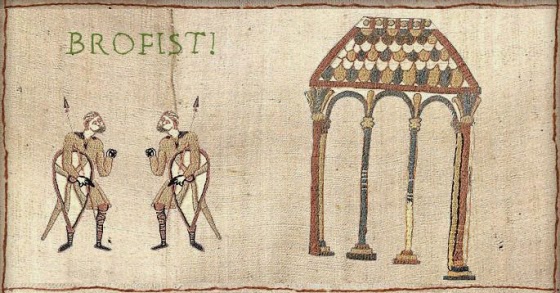As a satire, Andreas Capellanus' The Art of Courtly Love manages to make fun of or tick off pretty much everybody. And here I thought Jonathan Swift was good, but his plan to cannibalize the orphans doesn’t quite measure up to Capellanus’ work. The book’s tongue-in-cheek approach to love kind of mocks the courtiers who swooned (if there was dramatic swooning in the twelfth century) at the idea of a passionate, loving knight in shining armor. Of course, Capellanus probably didn't totally ridicule the idea; I imagine he believed in love between people as well, being that he was a cleric and all.
 |
| Eleanor of Aquitaine is not amused. |
To
make things better, the book is riddled with inside-inside jokes that would
have made medieval busybodies seethe with rage. There
are numerous subtle twists of Christian doctrine that only a literate person
who had read the Bible, essentially only priests and monks (and not even all of
them), would understand. Here are a few examples:
1a.
“[Love] can endow a man even of the humblest birth with nobility of character;
it blesses the proud with humility” (Capellanus 31).
1b.“[The
redeemed are] children of God, and if children, then heirs—heirs of God and
joint heirs with Christ” (Romans 8:16b-17a). And that “‘the last will be first,
and the first last’” (Matthew 20:16).
2a.
“A true lover considers nothing good except what he thinks will please his
beloved” (Capellanus 185).
2b.“Test
all things; hold fast what is good” (1 Thessalonians 5:21). And “'he who does
the will of My Father in heaven [shall be saved]'” (Matthew 7:21, which relates to
pleasing God). And “He who is unmarried cares for the things of the Lord—how he
may please the Lord” (1 Corinthians 7:32).
Others
might have said, “Andy, my man, we like you, but you took it a bit too far,
don’t you think?” That might be why he wrote a third book recanting the first
two satires…
Yet is it possible that Capellanus
believed that love was truly powerful, even as he poked fun at courtly love?
Perhaps he satirized courtly love in order to differentiate it as a corruption
of the love inspired by God. After all, this was a man whose doctrine stated
the greatest two commandments were to love God and to love one’s neighbor
(Matthew 22). His satire implies that love has a truly divine quality, although
courtly love does not. As some historians have pointed out, it is possible The Art of Courtly Love was meant to encourage
knights to behave well (Schwartz), but could it have also been meant as a not-so-gentle way to
encourage all courtiers to remember God as their first love?
If
so, maybe the priests were right to give him that fist bump after all… 
I wasn't quite sure if this was satire or not while I was reading it, but I was desperately hoping that it was. Satirically, it was a hilarious read because the rules were so ridiculous and utterly illogical, but I find it interesting that they seem to actually be mocking some of the Christian doctrines. I didn't catch that when I read it, but I can see what you mean after reading your post. Although, I have to admit that I only halfway understood your two examples of this.
ReplyDeleteI didn't think they were mocking so much as a subtle tribute to the teachings. Maybe that was meant to encourage people to reexamine the love in their spirituality, which is what I was wondering. I dunno.
DeleteSorry about the obscurity; I didn't even think about that as I was writing, and you guys deserve better than that. I'll try to be more on-point with that in the future. Here's what I was thinking for both examples:
1. Capellanus talks about the humble being noble and the noble being humbled. The same thought occurs a lot in the New Testament. For instance, the first quote traces how the humble humans have become joint heirs to heaven with Christ, in effect noble. The second quote was used a lot in descriptions of heaven, explaining that the "best" and "noblest" on earth might actually be humbled and "last" in heaven.
2. Capellanus is pretty self-explanatory. The first Biblical quote encourages readers to test everything and do what is good, insinuating that things that don't please God should not be considered "good," kind of like Capellanus' rule for the lovers. The second Biblical quote relates to the idea things that please God are good, part of His will, and part of the salvation plan. The third was a stretch, and I apologize for that; it kind of outlines a single person falling in love with God and doing what is pleasing to Him, and therefore what is "good" (similar to Capellanus).
I hope this helps.
This comment has been removed by the author.
ReplyDeleteAs I read The Art of Courtly Love I too thought that Capellanus was mocking the rules and stereotypical ways of how affection was felt between two people in love. The fact that these were so alike the Doctrines and how God wanted wellness and good, but what also surprises me as Sam mentioned was how Capellanus was borderline pushing for the extramarital relationships and expressing these feelings and actions with pride. It makes me wonder if Capellanus was speaking so passionately about this from experience, or if these were all descriptions of his imagination as what he saw fit in love at this time. Because if not, then I wonder if he truly supported what God's will of "good" really was. However, he did also speak passionately about how the rules were to God's liking. I am slightly confused as to how to think about all that Capellanus had to say.
ReplyDelete